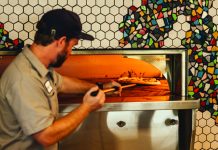My wife Julie and I reached a tipping point in our relationship. With our anniversary approaching on nearly the same day as Mother’s Day, we’ve now been together longer than we haven’t. Like a seesaw, with our childhood years on one end, and our doddering old age on the other, the weight of time and age quietly touched down in the sand. When I look at photos from the early years of our relationship, I realize that, although we may have felt like adults, we were just kids.
Certain patterns have emerged since those teen dating years. For one, I cook practically all the meals in the house and always have. However, there exist three important foods outside of my purview: Coffee, popcorn, and the much-exalted in our home, chocolate chip cookies, which belong solely to Julie. Those who know us well have most likely sampled all three and can attest to their quality. Over the years Julie has developed nuanced perceptions of detail only possible through repetition and refinement on a molecular level.
With her permission then, I present her chocolate chip cookie recipe. Actually the ingredients seem to me much the same as other good cookie recipes, and come adapted from a basic Tollhouse style and the famous Jacques Torres recipe printed in the New York Times, but the attention to detail (as usual, it’s the little things that matter) in the mixing, shaping, and cooking make all the difference.
 Julie’s Chocolate Chip Cookies
Julie’s Chocolate Chip Cookies
Makes roughly 36 cookies
2 1/4 cup all purpose flour
1 tsp baking soda
1 tsp salt
2 sticks butter cut into chunks
¾ cup brown sugar
¾ cup sugar
2 eggs
1 tsp vanilla 2 lbs chocolate bar cut into chunks
2 lbs chocolate bar cut into chunks
kosher salt for tops
Start by pulling the butter out of the refrigerator and allowing it to soften. This takes roughly 30 minutes, depending on the weather. Preheat the oven to 375. In a bowl, mix the dry ingredients with a whisk. Set aside.
In a large heavy bowl and using a fork*, push the butter into the sugar until it is all incorporated. Midway through the process, add the vanilla extract. Work all the sugar granules into the butter, making sure you haven’t left any behind.  Then add the eggs one at a time, mixing it with a fork until the mix is creamy and fully incorporated. Pour in the flour in thirds, again mixing with a fork. Stop mixing as soon as the flour is incorporated, keeping the dough soft. Add the chocolate chunks, reserving some for later. Mix them until they are evenly dispersed into the cookie dough.
Then add the eggs one at a time, mixing it with a fork until the mix is creamy and fully incorporated. Pour in the flour in thirds, again mixing with a fork. Stop mixing as soon as the flour is incorporated, keeping the dough soft. Add the chocolate chunks, reserving some for later. Mix them until they are evenly dispersed into the cookie dough.
Using a soupspoon, drop the cookie dough in one-inch balls onto a pan lined with a silicon-baking sheet or a greased cookie sheet. Space them evenly with 12 on a tray.  Place three to four pieces of the reserved chocolate chunks onto each cookie. This ensures that each cookie has chunks of chocolate on top, making for a more chocolatey-looking finished cookie. Visuals matter. Next sprinkle a couple grains of salt on each cookie; not so many that it’s noticeable, just a few.
Place three to four pieces of the reserved chocolate chunks onto each cookie. This ensures that each cookie has chunks of chocolate on top, making for a more chocolatey-looking finished cookie. Visuals matter. Next sprinkle a couple grains of salt on each cookie; not so many that it’s noticeable, just a few.
Place the tray in the hot oven and cook for nine to eleven minutes. Cook one tray at time. Cooking time is crucial and one tray is easier to control than trying to attend to multiple trays and the uneven heating in different sections of the oven. Rotate the pan in the oven after five to six minutes  or until the cookie dough has set but not started to brown. When they start to turn golden brown, but still have some blond parts in the middle, pull the tray from the oven. Soft cookies taste better and continue to cook a little as they cool, so err on the side of slightly undercooked as opposed to overcooked.
or until the cookie dough has set but not started to brown. When they start to turn golden brown, but still have some blond parts in the middle, pull the tray from the oven. Soft cookies taste better and continue to cook a little as they cool, so err on the side of slightly undercooked as opposed to overcooked.
Using a spatula, move the cookies to a cooling rack and repeat the process on a new tray. While the cookies taste great the next day, nothing beats eating them still warm. Try forming extra dough into cookie balls and storing them in the freezer. When you are ready for cookies, put the cookie balls on a tray, let them defrost, and add a couple minutes to the cooking process if they are still cold when you cook them.
*Do not use a mixer. According to Julie, using a fork is harder than using a mixer. It seems the suffering is a key ingredient in the cookies. The technology might make us faster, she says, but it allows our attention to stray. Working it by hand keeps you focused on the mix and makes it both harder to over-mix it and makes you more aware of when it’s done, because your arm starts to hurt.






